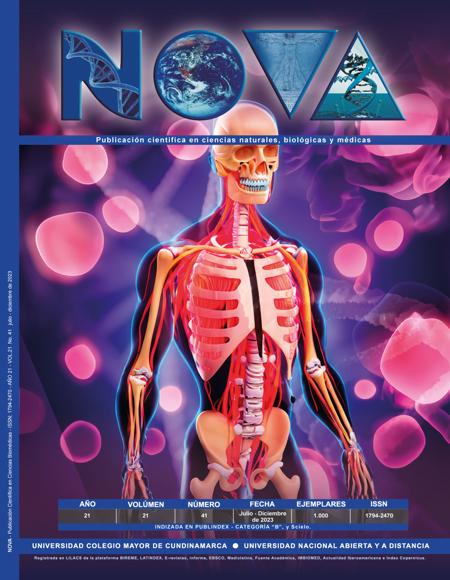Importance of the dilution test in the dosageof coagulation factors XII and XI in plasma with positive lupus anticoagulant
Importance of the dilution test in the dosage of coagulation factors XII and XI in plasma with positive lupus anticoagulant

Esta obra está bajo una licencia internacional Creative Commons Atribución-NoComercial-SinDerivadas 4.0.
Mostrar biografía de los autores
Introduction. Thrombosis is associated with acquired risk factors or hypercoagulable states. Antiphospholipid antibodies are found in infectious processes or associated with arterial or venous thrombosis. Among these is the lupus anticoagulant, which is conside- red an interference inhibitor because it prolongs phospholipid-dependent tests in vitro. Objectives. To relate the activity of factor XII and XI in patients with positive lupus anti- coagulant. Methodology. Of 55 plasmas, 34 met the inclusion criteria. Factors XII and XI were dosed by metric clot methods. Samples less than 50 Ul/dl are considered low factor activity, to which the dilution test (parallelism) is performed. If a recovery greater than 15% of the factor is evidenced, it is considered interference. If, on the contrary, the result remains with little variation, it is confirmed. factor deficiency. Results. Of 34 dosages, 79.4% (27/34) presented a decrease in factor XI. A dilution test was performed, and 100% recovery of factor XI was observed; Regarding the dosage of factor XII, 29.4% (10/34) presented values below 50 IU/dl and 70.6% (24/34) normal, did not recover in 22.2% (2/9) presenting deficit. Conclusions. The study of a prolonged PTT is carried out due to suspicion of lupus anticoagulant or factor deficiency. The importance of the laboratory is that every time a decreased coagulation factor is found, plasma dilution must be done to determine if there is recovery of the factor or is a deficit of this.
Visitas del artículo 143 | Visitas PDF 115
Descargas
Núñez-Álvarez CA, Cabiedes J. Pathogenic mechanisms of antiphospholipid antibodies. Rheumatol Clin [Internet]. 2011 ;7(1 ): 72–6. Available at: https://www.reumatologia- clinica.org/es-mecanismos-pathogenicos-anticuerpos-anti- fosfolipidos-articulo-S1699258X09002459
Garcia D, Erkan D. Diagnosis, and management of the an- tiphospholipid syndrome. N Engl J Med [Internet]. 2018 ;378(21) :2010–21. Available at: http://dx.doi.org/10.1056/ NEJMra1705454
Chaturvedi S, McCrae KR. Diagnosis, and management of the antiphospholipid syndrome. Blood Rev [Internet]. 2017; 31(6) :406–17. Available at: https://pubmed.ncbi.nlm.nih. gov/28784423/
Petri M. Improvements in diagnosis and risk assessment of primary and secondary antiphospholipid syndrome. Hema- tol Am Soc Hematol educate Progr . 2019; 2019(1): 415- 420.
Espinosa G, Cervera R, Font J, Reverter JC, Shoenfeld Y. Thrombotic mechanisms in antiphospholipid syndrome. Immunology [Internet]. 2003;22(1):53–62. Available at: https://ibecs.isciii.es/cgi-bin/wxislind.exe/iah/online/?IsisS- cript=iah/iah.xis&src=google&base=IBECS&lang=e&nex- tAction=lnk&exprSearch=37241&indexSearch=ID
Giannakopoulos B, Krilis SA. The pathogenesis of the an- tiphospholipid syndrome. N Engl J Med [Internet]. 2013 ;368(11) :1033–44. Available at: https://pubmed.ncbi.nlm. nih.gov/23484830/
Wang X, Cheng Q, Xu L, Feuerstein GZ, Hsu MY, Smith PL, et al. Effects of factor IX or factor XI deficiency on ferric chloride-induced carotid artery occlusion in mice: Thrombo- sis in FIX- and FXI-deficient mice. J Thromb Haemost [Internet]. 2005 ;3(4) :695–702. Available at: https://pubmed. ncbi.nlm.nih.gov/15733058/
Renné T, Pozgajová M, Grüner S, Schuh K, Pauer HU, Burfeind P, et al. Defective thrombus formation in mice lacking coagulation factor XII. J Exp Med [Internet]. 2005;202(2):271–81. Available at: https://pubmed.ncbi. nlm.nih.gov/16009717/
Del Carpio- Orantesa L. Deficiency of coagulation factors IX, XI, XII and systemic lupus erythematosus. Rev Hematol Mex. 2019;20(2):137-141.
Chaudhry LA, El- Sadek WYM, Chaudhry GA, Al- Atawi FE. Factor XII (Hageman Factor) Deficiency: a rare harbin- ger of life-threatening complications. Pan Afr Med J [Inter- net]. 2019; 33:39. Available at : https://pubmed.ncbi.nlm. nih.gov/31384354/
Giannakopoulos B, Gao L, Qi M, Wong JW, Yu DM, Vla- choyiannopoulos PG, et al. Factor XI is a substrate for oxido- reductases: enhanced activation of reduced FXI and its role in antiphospholipid syndrome thrombosis. J Autoimmune [Internet]. 2012 ;39(3) :121–9. Available at: https://pub- med.ncbi.nlm.nih.gov/22704541/
Emsley J, McEwan PA, Gailani D. Structure, and function of factor XI. Blood [Internet]. 2010 ;115(13 ): 2569–77. Avai- lable at: https://pubmed.ncbi.nlm.nih.gov/20110423/
Amory CF, Levine SR, Brey RL, Gebregziabher M, Tuhrim S, Tilley BC, et al. Antiphospholipid antibodies and recu- rrent thrombotic events: Persistence and portfolio. Cerebro- vasc Dis [Internet]. 2015 ;40(5–6):293–300. Available at : https://pubmed.ncbi.nlm.nih.gov/26513489/
Hell L, Ay C, Posch F, Gebhart J, Koder S, mackman N,Pa- binger I, Thaler J. low stracellillary vesicle-associated Tissue factor activity in patients with persistent lupus anticoagulant and a history of thrombosis. Ann Hematol . 2019 Feb;98(2): 313-319.
Mackworth-Young CG. Antiphospholipid syndrome: multi- ple mechanisms. Clin Exp Immunol [Internet]. 2004 ;136(3 ): 393–401. Available at: http://dx.doi.org/10.1111/j.1365- 2249.2004.02497.x
Hoxha A, Banzato A, Ruffatti A, Pengo V. Detection of lupus anticoagulant in the era of direct oral anticoagulants. Au- toimmune Rev [Internet]. 2017 ;16(2 ): 173–8. Available at: https://pubmed.ncbi.nlm.nih.gov/27988438/
Merriman E, Kaplan Z, Butler J, Malan E, Gan E, Tran H. Rivaroxaban, and false positive lupus anticoagulant testing. Thromb Haemost [Internet]. 2011;105(2):385–6. Available at : https://pubmed.ncbi.nlm.nih.gov/21103666/
Arachchillage DRJ, Mackie IJ, Efthymiou M, Isenberg DA, Machin SJ, Cohen H. Interactions between rivaroxaban and antiphospholipid antibodies in thrombotic antiphos- pholipid syndrome. J Thromb Haemost [Internet]. 2015; 13(7): 1264–73. Available at: https://pubmed.ncbi.nlm.nih. gov/25850997/
Pengo V, Denas G. Diagnostics, and treatment of thrombotic antiphospholipid syndrome (APS): A personal perspective. Thromb Res [Internet]. 2018 ;169 :35–40. Available at: ht- tps://pubmed.ncbi.nlm.nih.gov/30007134/
Favaloro EJ, Mohammed S, Curnow J, Pasalic L. Laboratory testing for lupus anticoagulant (LA) in patients taking direct oral anticoagulants (DOACs): potential for false positives and false negatives. Pathology. 2019 Apr;51(3):292-300.
Marine L, Urbina J, Bergoeing M, Valdés F, Mertens R, Kramer A. Mechanical and pharmacomechanical Throm- bolysis in deep venous thrombosis with no clinical respon- se to conventional treatment. Rev Med Chil [Internet]. 2017;145(1): 63–71. Available at: https://pubmed.ncbi.nlm. nih.gov/28393971/
Tripodi A, Cohen H, Devreese KMJ. Lupus anticoagulant detection in anticoagulated patients. Guidance from the Scientific and Standardization Committee for lupus anticoa- gulant/antiphospholipid antibodies of the International So- ciety on Thrombosis and Haemostasis . J Thromb Haemost . 2020; 18(7): 1569-1575.
Devreese KMJ, Ortel TL, Pengo V, de Laat B. Subcommi- ttee on Lupus Anticoagulant/Antiphospholipid A. Labora- tory criteria for antiphospholipid syndrome: communication from the SSC of the ISTH. J Thromb Haemost . 2018; 16(4): 809-813.
Cohen H, Mackie IJ, Devreese KMJ. Clinical and laboratory practice for lupus anticoagulant testing: an International So- ciety of Thrombosis and Haemostasis Scientific and Stan- dardization Committee survey. J Thromb Haemost . 2019; 17(10): 1715-1732.
Carmi O, Berla M, Shoenfeld Y, Levy Y. Diagnosis and management of catastrophic antiphospholipid syndro- me. Expert Rev Hematol . 2017 Apr;10(4):365-374. doi : 10.1080/17474086.2017.1300522. Epub 2017 Mar 13. PMID: 28277850.
Tektonidou MG, Andreoli L, Limper M, et al. EULAR re- commendations for the management of antiphospholipid syndrome in adults. Ann Rheum Dis. 2019; 78(10): 1296- 1304.
Srivastava A, Santagostino E, Dougall A, Kitchen S, Suther- land M, Pipe SW, et al. WFH Guidelines for the Manage- ment of Hemophilia, 3rd edition. Haemophilia [Internet]. 2020 ;26 Suppl 6(S6) :1–158. Available at: https://pubmed. ncbi.nlm.nih.gov/32744769/









